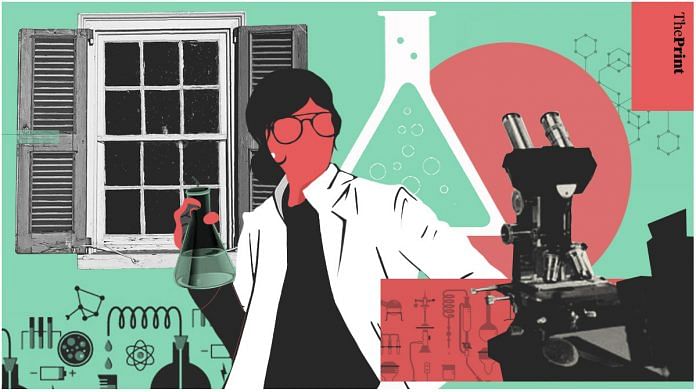New Delhi: The number of women in India who have opted for Science, Technology, Engineering and Mathematics (STEM) as a field of study has increased by 53,388 in the last three years — from 10,02,707 in 2017-18 to 10,56,095 in 2019-20, Education Minister Dharmendra Pradhan said earlier this week.
This is in contrast to the number of men who enrolled for studies in the field of STEM — from 12,48,062 in 2017-18 to 11,88,900 in 2019-20, according to the annual All India Survey on Higher Education (AISHE) report, which indicates enrollment in undergraduate, Masters, and PhD-level programmes.
In a written reply to the Lok Sabha Monday, Pradhan, citing the World Bank data, also said in terms of percentage, there are more Indian female graduates (43%) in STEM at the tertiary level than in developed nations like the US (34%), UK (38%), Germany (27%) and France (32%).
The AISHE report reflects an increase in women enrollment, particularly in medicine-related courses. The number of women who enrolled for BSc (Nursing) in the last four years was 445 (2015-16), 384 (2016-17), 379 (2017-18), 358 (18-19), and 385 (2019-20).
For the BSc course, the number went up from 94 (2016-17) to 113 (2019-20); for MBBS, it went up from 99 (2016-17) to 113 (2019-20). During the same period, enrolment in Bachelors in Technology course went up from 39 in 2016-17 to 42 in 2019-20.
What is STEM
STEM is a common abbreviation for four closely connected areas of study: Science, Technology, Engineering and Mathematics. The fields are often associated due to the similarities they share both in theory and practice. Till now, the representation of women in these fields has been much less compared to men. The push for increasing the number of women employed in STEM-related fields is something that several women scientists across the world have been calling for.
A survey by edtech platform, Avishkaar, found that 57 per cent girl students are interested in pursuing STEM — this is because of the increased awareness of the subject and access to online learning.
The rise of online learning platforms like Coursera and upGrad have also led to an increased participation by women. For Coursera, the share of STEM course enrollments by women learners in India increased to 33 per cent in 2020 from 22 per cent pre-2020, while upGrad saw a 27 per cent rise.
In February, Women and Child Development Minister Smriti Irani announced that 11 new chairs would be set up in prominent institutions of the country to encourage women to pursue STEM.
In order to increase the participation of women in science, the government has also initiated several schemes such as Knowledge Involvement Research Advancement through Nurturing (KIRAN). The scheme, launched in 2014-15, provides opportunities for women scientists in moving up the academic and administrative ladder.
One of the programmes under the KIRAN scheme — ‘Women Scientist Scheme’ — provides career opportunities to unemployed women scientists and technologists, especially those who had a break in their career.
Also read: Only 22% women in AI jobs — The gender gap in science and technology, in numbers
What women have to say
Women scientists and researchers ThePrint spoke to said getting STEM education may not necessarily translate into jobs for women.
Recently, Swedish Science Counsellor Fanny von Heland said about 43 per cent of STEM graduates in India may be women, which is the highest in the world, but their share in STEM jobs in India is a mere 14 per cent.
Nandita Jayaraj, science communicator and co-founder of the feminist science media project, The Life of Science, said: “In Indian STEM, the primary concern has never been with the number of women graduates, but with the proportion of those who ultimately land STEM jobs. While it’s always nice to have more young women studying STEM, these enlarged numbers should not be looked at as a victory; on the contrary, it should be an alarm bell for us. How many of these women will get STEM jobs? A very very tiny fraction.”
A 2016-17 NITI Aayog report, designed “to understand the reasons for the loss of trained female scientists from scientific manpower in India”, found that more women scientists want age relaxation in eligibility criteria, an extension of institutional provision of non-academic infrastructure like housing, transport and medical help, and flexibility in employment contracts allowing for choice regarding time commitment.
An ORF report said: “The paucity of women in STEM is not merely due to skill inadequacy, but also a result of assigned stereotypical gender roles. Women are likely to face ‘dual role’ syndrome, wherein professional decisions are largely affected by their domestic responsibilities.”
Preeti Aghalayam, faculty, Department of Chemical Engineering, IIT-Madras, said there are several challenges that women in STEM face but these increased enrolment numbers are a good sign.
“Women in STEM face a lot of challenges including lack of role models, pressures to conform to societal norms and trappings of domesticity, stressors related to marriage, childbirth etc., an inordinate amount of responsibility related to running of households and elder care, physical safety during the commute to work, sexual and other types of harassment in workplaces, and a whole host of other issues,” she said.
“It is not so much about how much education or how many degrees in STEM women acquire. It is a matter of having long, successful, fulfilling, and accomplishment-laden careers, where the women’s talents are utilised best, for their, their family’s and the nation’s betterment. While the situation is definitely improving, and the increase in numbers of women in STEM is indicative of this, the road is yet long. We have a long way to go.”
Also read: Where are the gutsy girls of Indian science? They could help us against next pandemic



